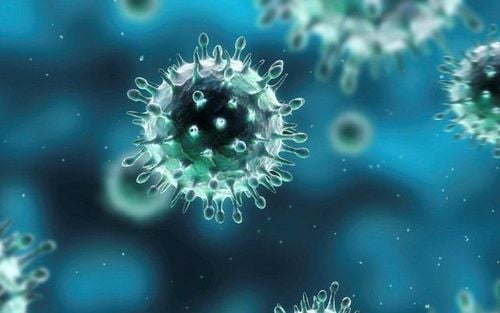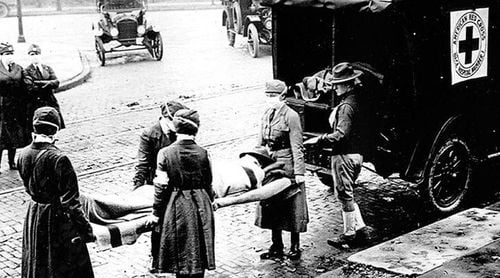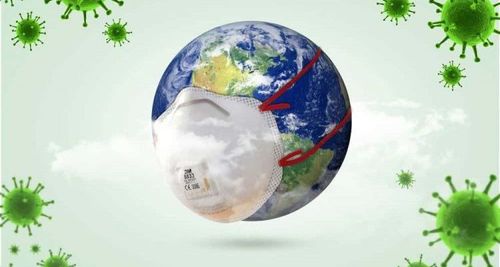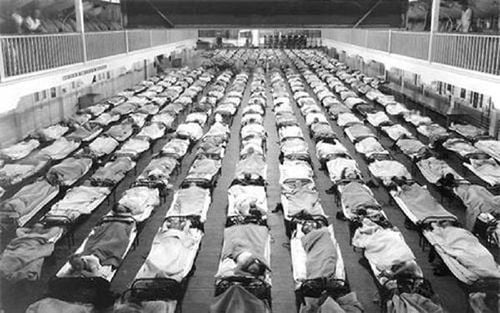This is an automatically translated article.
The 1918 Spanish flu pandemic was one of the deadliest pandemics in history. The epidemic infected about 500 million people worldwide (about a third of the population at the time) and resulted in 50 million deaths. The 1918 flu pandemic was first detected in Europe, the United States and parts of Asia before rapidly spreading around the world. At that time there was no vaccine and no effective treatment for the disease.
1. What is the flu?
Influenza is just a virus that attacks the respiratory system. Influenza virus is very contagious, when an infected person coughs, sneezes or talks, droplets will be released into the air, carrying the virus and can be spread to anyone near and inhaling. Also, if you touch something with the virus on it and then touch your mouth, nose, or eyes, you can also become infected.
Influenza viruses can mutate rapidly. Flu outbreaks occur every year and vary in severity, in part depending on the type of virus that's spreading.
Flu is usually seasonal, mostly from late fall to spring. In a typical year, more than 200,000 Americans are hospitalized for flu-related complications. And over the past three decades, there have been between 3,000 and 49,000 flu-related deaths annually in the United States.
Populations such as children, people over 65 years old, pregnant women and people with certain medical conditions such as asthma, diabetes, heart disease are at high risk for flu-related complications such as pneumonia, infection ear infections , sinusitis and bronchitis .

Bệnh cúm là do virus tấn công hệ hô hấp
An influenza pandemic, such as the 1918 flu pandemic, occurs when a particularly virulent strain of influenza virus emerges. Humans have not yet been immune to that virus, so the rate of human-to-human transmission globally is very fast.
Trắc nghiệm: Bạn có phân biệt được chính xác cảm lạnh và cúm mùa?
Cảm cúm và cảm lạnh là hai khái niệm mà chúng ta thường đánh đồng nó giống nhau, không phân biệt rõ ràng. Dưới đây là một số câu hỏi trắc nghiệm, giúp bạn có thêm những kiến thức phân biệt cảm lạnh và cảm cúm. Từ đó, có những biện pháp điều trị bệnh phù hợp.2. Symptoms of Spanish Flu
The first wave of the 1918 flu pandemic occurred in the spring and was generally mild. Patients will experience typical flu symptoms such as feeling chills, fever, fatigue and usually recover after a few days. The number of deaths reported at this time is still low.
However, a second flu wave occurred that fall, this time the disease was highly contagious and the sick person died within hours or days as symptoms developed. The patient's skin color turns blue, their lungs fill with fluid, causing them to suffocate and die. In just one year, the average life expectancy in the US has plummeted to a decade.

Bệnh nhân có triệu chứng ban đầu là sốt
3. What caused the Spanish flu pandemic?
At that time it was not known exactly where the particular strain of flu that caused the Spanish flu pandemic came from. However, the 1918 flu was first seen in Europe, the Americas, and parts of Asia before spreading to most parts of the planet within a few months.
Despite the fact that the 1918 flu was not isolated in Spain, it is known worldwide as the Spanish flu. The reason for that naming is because Spain is the worst-affected country in this pandemic and Spain has not suffered from wartime blackouts that affect other European countries. Even the king of Spain at the time, Alfonso XIII, was infected with the flu.
An unusual feature of the 1918 flu pandemic was that it knocked out many healthy young people of the time. This is a group of people who can usually fight off this infectious disease on their own. Even soldiers in World War I caught the 1918 flu.
In fact, more American soldiers died from the Spanish flu than were killed in the war. Up to 40% of the US Navy has contracted the flu, 36% of the military has fallen ill, and the movement of troops around the world in crowded ships and trains has allowed this deadly virus to spread quickly. . Even President Woodrow Wilson of the United States was reported to have contracted the flu as early as 1919 while negotiating the Treaty of Versailles, which ended World War I.
Although the death toll from the Spanish flu is estimated at 20 - 50 million people, there are other estimates that up to 100 million people or a third of the world's population at that time were infected. But we cannot know the exact number due to lack of medical records in many places.

Có khoảng 1/3 dân số thế giới nhiễm cúm
4. How did the world fight the Spanish flu pandemic?
When the flu struck in 1918, doctors and scientists weren't sure what caused it, nor were they sure how to treat it. This is completely unlike today, there is no vaccine, there is no effective antiviral drug, and there is no medicine to treat the flu.
The flu epidemic that year had another problem: World War I with a shortage of doctors and medical staff. And among health care workers in the US, many have contracted the flu.
In addition, the overwhelming number of sick people has caused hospitals in some areas to become so overwhelmed that schools, homes and other buildings have been converted into temporary hospitals. .
In some communities that have imposed quarantines, ordered all citizens to wear masks and closed public places including schools, churches and theatres, libraries halted lending of books . People are advised to avoid shaking hands, to stay at home, a number of other regulations have been adopted such as banning spitting in public places.
During the pandemic, Boy Scouts in New York City approached people they saw spitting in the street and gave them cards that read: “You are violating the Sanitation Code” .
5. The Spanish flu pandemic caused heavy damage to society
The 1918 Spanish flu pandemic took a toll on people, causing many families to lose loved ones, leaving countless widows and orphans. Funeral homes were overcrowded, bodies piled up. Many had to dig their own graves for their family members.
Đại dịch cúm gây ra thiệt hại nặng nề về người và của
The 1918 flu pandemic also took a huge toll on the economy. In the United States, many businesses have been forced to close because so many of their employees are sick. Basic services such as mailing and garbage collection have been hampered due to flu-stricken workers.
In some places there are not even enough workers to harvest crops on farms. Even state and local health departments were closed, hindering efforts to document the spread of the 1918 flu.
6. How did the Spanish flu pandemic end?
It was not until the summer of 1919 that the influenza pandemic ended because those infected died or were already immune to the disease.
Almost 90 years later, in 2008, scientists announced they had discovered what made the 1817 flu so deadly: a group of three genes that enabled the virus weakens the victim's bronchial tubes and lungs, it clears the way for the patient to develop bacterial pneumonia.
Since the 1918 Spanish flu pandemic, there have been several other flu pandemics, but the number of deaths is still less than the 1918 flu. So far, the 1918 flu pandemic is still the flu. dangerous and left the most severe consequences in human history.
Please dial HOTLINE for more information or register for an appointment HERE. Download MyVinmec app to make appointments faster and to manage your bookings easily.
Article reference source: nationalgeographic.com, history.com












